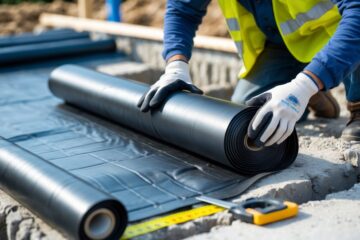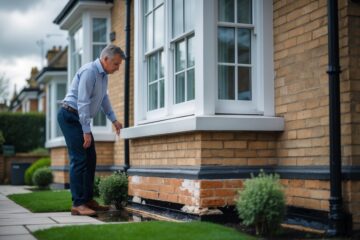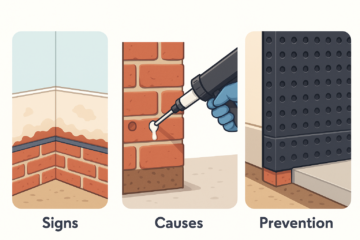London’s damp problem isn’t just bad luck or poor housekeeping. The city’s unique combination of high rainfall, old housing stock, and dense urban environment creates perfect conditions for moisture problems in properties across the capital.
Whether you’re a homeowner, tenant, or landlord, understanding why damp occurs so frequently here can save you time, money, and maybe even some health troubles down the line.
Most London properties face damp issues because of factors you can’t control, like the city’s wet climate and Victorian-era construction methods.
Still, you can do plenty once you understand the root causes.
Key Takeaways
- London’s wet climate and old housing stock create ideal conditions for damp problems in properties
- Damp can cause serious health issues, including respiratory problems and worsen existing conditions like asthma
- Early detection and proper treatment methods can prevent minor damp issues from becoming costly structural damage
Why Damp Is Rampant in London Properties
London’s climate creates perfect conditions for moisture problems. The city’s historic building stock and dense urban layout compound these issues.
High humidity, poor airflow, and ageing infrastructure combine to make damp a stubborn challenge for property owners across the capital.
London’s Unique Weather and High Humidity
London’s temperate maritime climate keeps humidity levels consistently high throughout the year. The city experiences an average relative humidity of 75-80%, which is well above the 60% threshold where damp problems typically begin.
Your property faces constant moisture pressure from London’s frequent rainfall. The city gets about 584mm of rain every year, spread across 164 days.
This constant moisture soaks the air and building materials. Indoor humidity in London homes regularly exceeds 70% during winter months, and poor heating and ventilation systems just can’t handle this much moisture.
The temperature difference between heated interiors and cold exterior walls creates condensation hotspots. The Thames River adds another layer of atmospheric moisture, especially for properties within 5 miles of the river.
Those homes experience humidity levels 5-10% higher than those further inland. This makes damp problems even worse in central London boroughs.
Prevalence of Older Buildings in London
Over 60% of London’s housing stock was built before 1945, with many properties dating back to the Victorian era.
These older buildings lack modern damp-proofing measures and moisture barriers that keep water out.
Victorian terraced houses usually have solid brick walls without cavity insulation. These walls soak up moisture from rainfall and rising groundwater.
Your period property might not have an effective damp-proof course, so moisture rises through the foundations.
Original building materials like lime mortar and wooden window frames are more susceptible to moisture damage than modern alternatives. They expand and contract with humidity changes, which creates gaps where water sneaks in.
Many older London homes have been renovated multiple times, often with materials that don’t play nicely together. Modern cement renders slapped onto lime-based walls can trap moisture, stopping natural evaporation and making damp conditions worse.
Urban Density and Airflow Restrictions
London’s dense urban environment restricts natural airflow around buildings. Narrow streets and closely packed homes create wind shadows that stop moisture from evaporating properly.
Your property might have poor ventilation because of limited external airflow. High-rise developments and packed neighborhoods create micro-climates with stagnant air, so moisture just lingers around the building exteriors.
Urban heat islands in central London cause temperature inversions that trap humid air. The city centre runs 2-5°C warmer than surrounding areas, which increases moisture in the atmosphere.
Pollution particles in London’s air act as condensation nuclei, encouraging water droplets to form. This bumps up indoor humidity as contaminated air enters your home through vents and open windows.
Main Causes of Damp in London Homes
London homes face damp issues mostly because of structural problems like leaking roofs and failed damp-proof courses, plus environmental factors such as poor ventilation that leads to condensation.
Leaking Roofs and Roof Leaks
Your roof is the first line of defence against London’s frequent rain. When tiles crack or slip, water gets straight into your property.
Missing or broken guttering lets water overflow and run down outside walls, causing penetrating damp that shows as damp patches on internal walls and ceilings.
Roof leaks often start small but get worse quickly. You might spot water stains on upper-floor ceilings or walls during heavy rain.
Victorian and Edwardian homes often have ageing roof timbers and worn-out lead flashing. These materials just can’t hold up forever in London’s wet climate.
Signs of roof-related damp:
- Water stains on ceilings
- Damp patches after rainfall
- Musty odours in upper rooms
- Peeling paint or wallpaper
Damaged or Missing Damp-Proof Course
Your damp-proof course (DPC) is supposed to stop ground moisture from rising through the walls. Many London homes have damaged or missing DPCs because they’re just so old.
Rising damp happens when moisture travels up through masonry by capillary action. Usually, you’ll see a horizontal band of dampness along ground floor walls.
Older homes often have slate or bitumen DPCs that break down over time. Some Victorian houses never had proper DPCs at all, relying on thick walls that just don’t cut it anymore.
Sometimes, the ground outside rises above the DPC after years of landscaping changes, which basically cancels out your damp protection.
Modern chemical DPCs can fail if they’re installed wrong or if the building settles unevenly. You might need a damp specialist to check if your DPC needs fixing or replacing.
Penetrating Damp from Structural Issues
Penetrating damp gets in through your property’s external walls, usually during windy, rainy weather. London’s climate is tailor-made for this kind of moisture ingress.
Cracked pointing between bricks lets water seep through mortar joints. Victorian homes often have lime mortar that turns porous as it ages.
Cavity wall insulation can cause trouble if installed badly. Moisture bridges form when insulation touches both the inner and outer walls.
Bad window frames and door seals create easy entry points for water. You’ll see damp patches around these spots, especially after storms.
Single-brick walls in older homes offer less protection than modern cavity walls. These solid walls just soak up moisture during long wet spells.
Condensation from Poor Ventilation
Condensation forms when warm, moist air hits cold surfaces in your home. London’s humid climate and poor ventilation make this a common headache.
Everyday stuff like cooking, showering, and even breathing adds a lot of moisture to the air. If you don’t have good ventilation, this moisture settles on walls and windows.
Double glazing can make condensation worse if your home isn’t ventilated properly. The insulation traps moisture inside instead of letting it escape.
You’ll often see condensation on windows first, then on walls behind furniture or in corners where air doesn’t circulate.
Rooms that aren’t heated regularly develop cold spots where moisture loves to condense. Inadequate heating patterns just make things worse.
Health Impacts of Damp and Mould
Damp and mould in London homes can trigger serious respiratory problems like asthma attacks, cause allergic reactions from airborne spores, and create musty odours that mess with your daily wellbeing.
Respiratory Problems and Asthma
Mould spores float through the air when disturbed and can irritate your lungs. If you have asthma, these spores often trigger attacks and make symptoms worse.
You might notice more coughing, wheezing, or shortness of breath in damp rooms. Kids and elderly people face higher risks from mould exposure.
Common respiratory symptoms include:
- Persistent coughing
- Chest tightness
- Difficulty breathing
- Increased asthma medication usage
Prolonged exposure can lead to more serious breathing problems. Your symptoms usually get worse during humid weather when mould grows faster.
Allergic Reactions Caused by Mould Spores
Mould spores act as allergens and can trigger reactions even if you’re not allergic to other stuff. You don’t have to have hay fever to get hit by mould allergies.
Symptoms often look like hay fever and can happen any time of year. Your immune system treats mould spores like invaders, which sets off inflammation.
Typical allergic reactions include:
- Sneezing fits
- Runny or blocked nose
- Itchy, watery eyes
- Skin rashes or eczema flare-ups
Some folks develop worse reactions over time. Your symptoms may flare up in rooms with visible mould or poor ventilation.
Musty Odour and Its Effects on Wellbeing
That musty smell means mould is actively growing and releasing volatile organic compounds. Every time you catch that earthy, stale scent, you’re breathing in those chemicals.
The smell alone can give some people headaches or nausea. If your bedroom has a persistent musty odour, your sleep quality can really suffer.
Effects on your wellbeing include:
- Headaches and dizziness
- Nausea and stomach discomfort
- Sleep disruption
- Reduced concentration levels
The odour usually gets stronger in closed-up spaces with poor air flow. You might notice the smell is worse during rainy spells when humidity spikes.
Detecting, Preventing and Treating Damp
Catching damp early by checking visually and getting professional surveys can save you thousands in repairs. Damp proofing, better ventilation, and targeted treatments help fix existing issues and stop new ones from popping up.
Key Signs of Damp in Properties
Visual indicators are often the first clue that damp has moved in. Look for dark patches or stains on walls, especially near skirting boards or around windows where moisture sneaks in.
Peeling wallpaper and paint often mean there’s moisture under the surface. You might see wallpaper lifting at the edges or paint bubbling and flaking off walls.
Musty odours are another clear warning sign. That tell-tale smell often shows up before you see any visible damage, especially in basements, bathrooms, or stuffy rooms.
White salt deposits on walls (efflorescence) mean water’s been drawing salts from the masonry to the surface. This crystalline stuff shows up as your walls dry out after moisture exposure.
Mould growth shows up as black, green, or brown spots, usually in corners, around windows, or behind furniture. Condensation on windows, especially in winter, points to poor ventilation that can lead to bigger damp problems.
Warped or rotting wood around window frames and skirting boards means moisture has been there a while and needs quick attention.
Benefits of a Professional Damp Survey
A damp survey gives you a much clearer picture of moisture issues than just looking around. Specialists use electronic moisture meters and thermal imaging cameras to spot hidden damp behind walls and under floors.
Professional surveyors can pinpoint exactly what type of damp is affecting your place. Rising damp, penetrating damp, and condensation all need different fixes, so getting it right matters.
Detailed reports from damp specialists usually come with moisture readings, photos, and clear recommendations for what to do next. This paperwork is a lifesaver when you’re dealing with insurance or negotiating a property sale.
Early detection through a professional survey can save you a lot of hassle. If you catch damp early, you’ll likely spend 60-80% less on repairs than if you wait.
Certified damp surveys offer peace of mind during property transactions. Buyers and sellers can make smarter choices with all the facts in hand instead of just guessing.
Effective Damp Proofing Solutions
Chemical damp proof courses involve injecting silicone-based solutions into the walls to block moisture. This approach works well for older homes where the original damp proofing has failed or was never installed.
Physical damp proofing means putting in new damp proof membranes during renovations. These plastic or bitumen sheets can keep rising damp at bay for decades if installed right.
Tanking systems are a go-to for basements and below-ground spaces where standard damp proofing just isn’t enough. These waterproof coatings seal everything off from outside moisture.
| Damp Proofing Method | Best For | Typical Cost | Lifespan |
|---|---|---|---|
| Chemical injection | Rising damp | £15-25 per metre | 20-30 years |
| Physical membrane | New construction | £8-15 per metre | 50+ years |
| Tanking systems | Basements | £40-80 per m² | 25-40 years |
External waterproofing treatments tackle penetrating damp right at the source. You might need to repoint masonry, use breathable sealants, or set up drainage around the foundations.
Ventilation and Extractor Fan Upgrades
Extractor fans pull moist air out of bathrooms, kitchens, and laundry rooms before it can turn into condensation. Newer models with humidity sensors kick in automatically when things get too damp.
Adding extractor fans in problem spots can cut condensation by up to 90% if you size and place them well. Bathrooms usually need 15-20 air changes per hour, while kitchens do fine with 10-15.
Positive input ventilation systems push fresh filtered air through your home and flush out the old, humid stuff. They’re especially handy if you’re dealing with damp in several rooms.
Heat recovery ventilation systems grab warmth from outgoing air and use it to heat the incoming air. That way, you keep things comfortable and still get good airflow to fight condensation.
Keep your ventilation systems in good shape. Clean extractor fan filters every month, and check ducts for blockages that might slow things down and let moisture build up.
Summary
London’s damp issues come from a bunch of overlapping factors. The city’s climate really doesn’t help—there’s plenty of rain and humidity, which creates perfect conditions for moisture to sneak in.
Key Contributing Factors:
- High annual rainfall (over 600mm per year)
- Consistent humidity levels above 70%
- Limited sunshine hours for natural drying
- A dense urban environment restricts airflow
The age of your property plays a big part. Victorian and Edwardian homes often miss out on modern damp proofing, so they let in more moisture than newer builds.
Common Property Vulnerabilities:
- Single-glazed windows – cause condensation buildup
- Poor ventilation – traps moisture indoors
- Damaged guttering – allows water penetration
- Cracked pointing – creates entry points for moisture
The River Thames adds its own twist. Homes close to the river deal with higher ground moisture and sometimes flooding when it rains hard.
Three Main Damp Types Affecting London Homes:
- Rising damp – moisture travels up through walls
- Penetrating damp – water enters through external walls
- Condensation – warm air meets cold surfaces
Modern life doesn’t help much either. Cooking, showering, and drying laundry indoors all add moisture if you don’t have enough ventilation.
Your heating patterns play a role, too. If you heat your place on and off, you get temperature swings that encourage condensation, and poor insulation just makes the cold spots worse.
Knowing what’s behind the damp makes it easier to spot why it’s so common in London homes—and helps you figure out what steps to take to keep it at bay.
Frequently Asked Questions
London’s damp problems come down to a mix of weather, building materials, and old design choices that all add up to a perfect storm for moisture. These issues hit everything from Victorian terraces to new flats across the city.
What’s behind all this mould and mildew in London homes?
London’s humidity hovers around 70-80% most of the year, so it’s no wonder mould loves it here. Mould spores thrive in these damp conditions.
Older homes often trap moisture inside because they lack good ventilation. Many places just don’t have enough extractor fans or airflow.
Everyday stuff like cooking and showering pumps water vapour into the air. Without proper ventilation, that moisture ends up on cold windows and walls.
Could the classic London weather be wrecking my walls?
London gets about 600mm of rain each year, and there’s almost always a bit of drizzle. Over time, this constant damp seeps into building materials.
The mild temperatures mean walls rarely dry out completely. Exterior walls can stay damp for months, especially in autumn and winter.
Wind-driven rain doesn’t help either. It hits from all angles, pushing water into brickwork, mortar, and around windows.
Why does my London basement flat always feel like a swamp?
Basements sit below ground, so rising damp is pretty much a given. Groundwater can make its way through foundations and walls.
Bad drainage around buildings lets water pool next to the basement walls. That creates pressure and eventually forces moisture through the masonry.
Basements don’t get much natural light, so surfaces stay cooler. When warm, humid air hits those cold walls, you get condensation.
Aren’t Victorian houses to blame for the moisture madness around here?
Victorian properties were built with solid brick walls and usually no damp-proof courses. Most original membranes have broken down after 150 years.
Lime mortar in these old buildings is more porous than modern cement. That lets moisture travel through the walls more easily.
Single-glazed sash windows with bad seals are common in Victorian houses. Those cold spots pretty much guarantee condensation.
What are your best bets for drying out these stubborn London damp patches?
Install proper ventilation—extractor fans in kitchens and bathrooms really help. Mechanical ventilation with heat recovery is a smart move for London’s climate.
Dehumidifiers can bring indoor moisture below 60%. That’s usually enough to keep condensation and mould at bay.
Improve insulation on external walls to cut down cold spots. Internal wall insulation can make a big difference in fighting condensation in London homes.
How come new builds in London still struggle with dampness?
Modern construction methods can trap moisture during the building process. Concrete and plaster need time to dry out fully before anyone moves in.
Some new-build developments just don’t have proper ventilation for London’s damp climate. Builders sometimes go for the cheapest equipment to keep costs down.
Airtight homes need mechanical ventilation to actually work. Trouble is, a lot of residents aren’t quite sure how to use these systems day-to-day.


